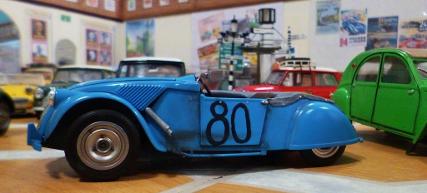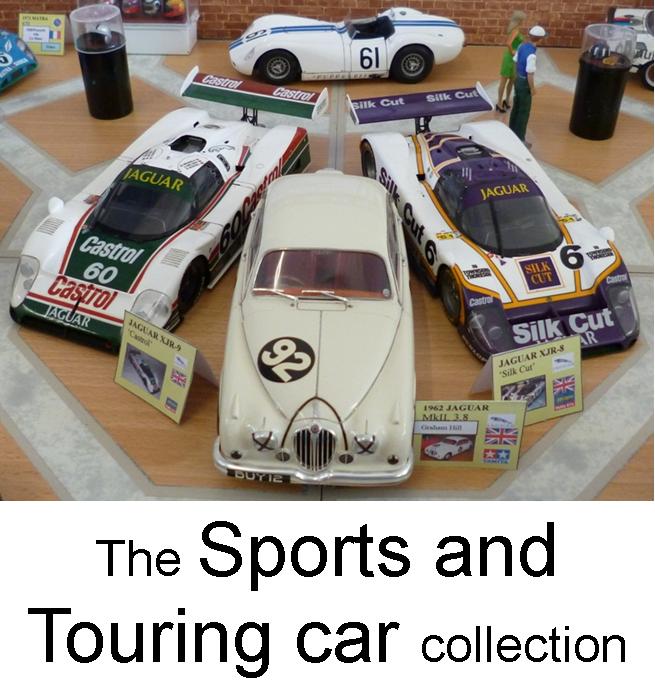
1953 Pierre Barbot 2CV "special".
The most improbable motor car to consider turning into a racing car would be the “tin snail”, sorry, the Citroën 2CV. Tiny engines, rough and ready looks and no aerodynamics, the only thing the 2CV had in its favour was its endurance. They just keep on going, whatever the terrain, the weather or the distance. The 2CV was a triumph of practicality over substance, yet one man dared to dream of winning races with a 2CV.
Such a man must surely be quite mad, well, not really. Pierre Barbot was an engineer, a director of a precision engineering company and a student of the sciences. Far from the ridiculous idea some thought the "barquette" Barbot envisaged was a very sensible prospect with as much a chance of success as any other car ever. The story of the Barbot Citroën 2CV Spéciale is simply too interesting to ignore.
The Citroën 2CV had a low price, very low weight and plentiful supply of cheap spare parts. The technology was proven and the durability of this simple French car was already becoming legendary. Once you consider that the world of motorsport is riddled with all manner of classes for engine size, vehicle size and weight, fuel consumption rates, and sundry other methods of differentiating between vehicles, then the 2CV becomes a serious prospect in the competition for class wins and endurance records. Pierre Barbot was the only man who saw this potential and he set about transforming a humble 2CV into a competition car to take on the world.
Launched in 1948 the 2CV was only a few years old when Barbot started to turn is idea into a reality in September 1951. Over the next two years he transformed “the farmers car” with a maximum speed of 65kph into a world record setting competition car and, unbelievably, he did it by reducing the 375cc engine capacity still further!
Barbot first drew an outline of the Barbot Spéciale in September 1951 with work soon commencing, taking two years to complete this extensive transformation. The most obvious differences are external, the roof was cut off at the height of the air vent, below the windshield, with the waistline lowered. The importance of this exterior transformation is in the amount of weight reduced by the removal of unnecessary panels and in helping the car become more aerodynamic. The lowering of the centre of gravity also helps in the overall handling of the car. The final look of this roofless two door (the recycled rear doors!) roadster shares little in common with the original Citroën 2CV, in fact, the only original unmolested panels were the rear wings, the front having had new head lamps faired into them. To ensure the car retained some Citroën 2CV identity the bonnet was kept but somewhat flattened, lowered by around 10cm and lengthened by approximately 30cm.
In keeping with achieving minimal weight targets the largest part of the cockpit and rear bodywork is covered by a tonneau made from the original roofing material.
With the dual aims of reducing weight and improving handling the chassis was shortened by 25cms. The suspension mountings were altered a little in this wheelbase reduction making it closer to 15cm reduction instead of the 25cm of the chassis. The suspension system was reworked by removal of the heavy self-levelling fittings and using rubber band style Neiman rings. This was engineered into a system that also lowered the ride height. These refinements made the chassis stiffer and gave the car much better handling and manoeuvrability. The whole thing rolled on special rims sporting 125 x 400 tyres.
The new bonnet covered the entire front end from bumper to dashboard. It was easy to remove for servicing and gave plenty of room to work on the engine. One little detail on the bonnet was an access hatch hidden under the Barbot engineering badge which meant the oil level could be topped up without removing the whole bonnet.
Talking of what’s under the bonnet, the standard 1948 2CV motor was a 375cc (cubic centimetre) flat 2-cylinder unit that churned out a meagre 9hp dragging the "umbrella on wheels" to a top speed of 65kph (40mph). This sort of performance would not normally have anyone rushing to turn the car into a competition machine, and when Barbot actually reduced its capacity further, to 348cc, many observers must have wondered what was coming next. What was coming next was the clearest indication that Barbot knew exactly what he was about. Two Solex 32 PBIC carburettors, one for each cylinder, sans filters, replaced the single unit of the basic engine and a special camshaft was fitted. A modified direct exhaust pipe for each cylinder also helped the engine breathe more freely. By the time Barbot had finished tuning his motor he had actually raised the power output from 9hp to 14hp.
Combining a power increase to more stability, better aerodynamics and a much, much lighter car meant Babot’s dream of competition became a real possibility. The car now qualified for the FIA ‘J’ class (under 350cc) in competition and record attempts. Two 20ltr fuel tanks installed in the boot also went a long way to making endurance runs a serious option.
In the cockpit the seat position was lowered, as was the steering wheel height; the steering wheel being a “Quillery” ‘wheel, a popular accessory of the era designed with safety in mind. The A simple dashboard was manufactured with the necessary instrumentation, including a rev’ counter that was powered by a cable off the front axis of the fan!
The Bol d’Or
Pierre Barbot had hoped to enter his car in the prestigious Montlhery 24hr Bol d’Or, “golden bowl”, in 1952 but his plans did not come to fruition; 1953 was a different matter though. On the 21st of June 1953 at Autodrome de Linas-Montlhéry (near Paris, France), the twenty-fifth Bol d'Or Automobile was held.
Carrying race number 80 the Barbot Special 2CV hit the track driven by the 19-year-old Jean Vinatier, a gifted young pilot only just old enough to have his driver's license. At this time he was just making his name, and he was about to raise his standing in the racing fraternity by a huge amount.
Finishing 19th overall in the 1953 Bol d'Or Jean Vinatier not only won the under 350cc class but set a new 24-hour distance travelled record. The Barbot Special 2cv covered 1,649.309km at an average 68.721kph, this despite Vinatier having to push the car for 2km due to a broken rocker arm stopping the car.
Impressed? Consider this then, at that time the rules allowed only one driver, no team mates Vinatier had to drive the entire 24hrs alone.
Records
After the achievements at the Bol D’or, Yacco oils stepped in to sponsor the car for an attempt on a whole set of under 350cc class records. Montlhery was known as a speed record track so it was an obvious choice for Barbot, Vinatier, the little 2CV Spéciale (with some further aerodynamic improvements especially around the exhausts) and the back-up team to return to the famous circuit on the 27th September 1953.
Needless to say, the little car and its drivers, Jean Vinatier, his father and Pierre Barbot himself, set a raft of new Class J records, nine to be correct, that are really quite impressive for such a small capacity car.
- 200km in 3h28m36s (average 92.13kph);
- 500km in 5h28m46s (average 91.25kph);
- 750km in 8h47m51s (average 91.46kph);
- 1,000km in 10h59m09s (average 91.03kph);
- 1,500km in 18h24m16s (average 87.44kph);
- 2,000km in 23h32m13s (average 84.87kph);
- 6-hours distance of 547.672km (average 91.28kph);
- 12-hours distance of 1,091.577km (average 90.96kph);
- 24-hours distance of 2,040.469km (average 85.02kph).
Vinatier Later commented on the car and the successes with the Barbot special: “… I won my category at the Bol d'Or, driving a 2cv built by Pierre Barbot, an industrialist in Montreuil. At that time, we drove alone for 24 hours. With this 2 CV, we then beat nine International records in Montlhéry with my father and Pierre Barbot.”
Jean Vinatier’s connection to the Citroën 2cv didn’t end here though. He drove one of the 2hp cars for 40,000km during a Tour of Africa rally, one of the steps that set him on the road to fame as an endurance rally driver.
One car or two?
No original 2CV Barbot “barquette” has survived the rigors of time, probably being scrapped for parts in the dim distant past. However, this much-admired vehicle has been the subject of several replicas paying homage to the achievements of Barbot, Vinatier and the 2cv special.
The research that has been undertaken in creating these replicas has thrown up the idea that there may have been more than one Barbot 2CV Spéciale. Certainly, the building duration between 1951 and 1953 means multiple vehicles could have been built. The main reason for this “more than one” belief is that there are photographs showing two different number plate configurations. It is most likely there was only one car with registered differently at different times but the truth will perhaps not be proved either way.
The many replicas all have differences depending on the individual builders’ interpretation of the original and the different configurations it ran in. The main thing is that this wonderfully evocative little car and the achievements of Barbot and Vinatier are being remembered, and even recreated, today.
One of the 2cv recreations was run at Montlhéry in 2016 for 6 hours. Bruno Viet, Dominique Pascal, Jean Baptiste and a certain Jean Vinatier (yes, the original record setter himself) took the car each taking a 90minute stint behind the wheel. The car ran faultlessly completing 260 laps of the 2.545km circuit, covering 643.88km. That’s an average of 104,31kph, considerably more than the original. However, this isn’t a fair comparison in that the recreation had a 600cc engine developed Dieselec Api of Soissons. The latest team is well aware of the differences explaining:
"No glamor is to be drawn from this evocation which was simply to make us happy and finalize an idea already old, an idea of passionate."
Passion we understand, this model is our way of remembering the achievements of Barbot, Vinatier and all those mentioned above, through a medium we are passionate about.
Jean Vinatier
Born in 1933 the son of race mechanic who drove endurance rallies with his wife pre-war, Jean Vinatier was the great French hope for motor racing and he did go on to have a Stella career as an endurance rally and racing driver.
After his Citroen adventures with the Barbot special and around Africa Jean Vinatier drove a Renault 8 Gordini to win the 1964 “Tour de Corse”. Moving to the Alpine team in 1968 and 1969 he won two Alpine Rallyes without penalty driving the Alpine-Renault A110, he ran penalty free again in 1971, driving an 1800cc Alpine-Renault A110 with Lucette Pointet, to become one of the very few people (a very short list including Ian Appleyard and Stirling Moss) to complete three Alpine rallyes without penalty points to be awarded a Coupe d'Or (Gold Cup). 1969 was also the year that Vinatier won the French Rally Championship, again driving the Alpine A110.
Vinatier had a short career in the International Championship for Manufacturers before it was morphed into the World Rally Championship. He finished third behind the Porsche 911s of Björn Waldegård and Gérard Larrousse in the 1969 Monte Carlo Rally.
In endurance events Vinatier was one of the 391 cars, across 25 classes, entered for the 1957 Mille Miglia, the last of the great Mille Miglia events. He was the first driver to pass the scene of the fatal crash that killed Alfonso de Portago, his American navigator Edmont Nelson and ten spectators, including five children, another 20 people were injured. This awful crash scene was the final nail in the coffin of the once coveted open road races.
Vinatier was entered in the Le Mans 24Hrs 14 times between 1958 to 1973. His best result overall was eighth place in 1968 driving an 3L V8 Alpine A220 with André de Cortanze. He was a class winner in 1967, with Mauro Bianchi (brother of Lucien Bianchi), driving an 1470cc Renault-Gordini engined Alpine A210 in the P1.6 class.
When Vinatier retired from racing he worked as Competitions Manager for Ford France (his last le Mans 24hrs was driving a Capri for Ford of France), later he became a technical manager at the FFSA (Fédération Française du Sport Automobile) and finally a technical delegate for the FIA (Fédération Internationale de l'Automobile).




















